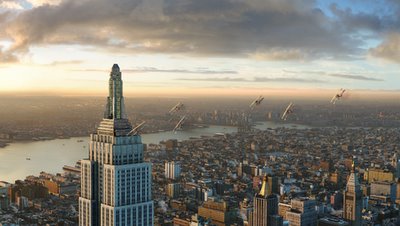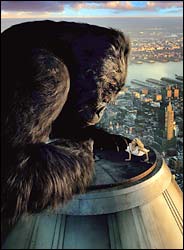 [Image: Peter Jackson's entirely computer-generated Manhattan, created for his remake of King Kong; spotted at this quick and entertaining history of that film, including early Modernist high-rise design, Italian futurism and the radio dreams of an earlier era – reactions to the city, crossing species lines].
[Image: Peter Jackson's entirely computer-generated Manhattan, created for his remake of King Kong; spotted at this quick and entertaining history of that film, including early Modernist high-rise design, Italian futurism and the radio dreams of an earlier era – reactions to the city, crossing species lines].How do other species survive in our cities? King Kong, The Birds, Willard, King Rat. The brutalist concrete masses of Modernist architecture, swelling upward into towers on the edges of parks. Distracting birds to their death. Home to roaches and rats.
"As we lure animals into urban environments with promises of food and shelter, we could be exposing them to hazards they are ill-equipped to handle," we read in New Scientist.
"In British cities," for instance, "foxes are now commonplace. In southern California, bighorn sheep journey down from the mountains to feed on lush lawns. Further up the Pacific coast, Canada geese nest on balconies and roofs in Vancouver. And in Australia, Melbourne is witnessing the return of rainbow lorikeets, flashy parrots not seen in the city since the 1920s. Even peregrine falcons – majestic birds of prey redolent of lonely sea cliffs and wide-open country – have gone urban. In the heart of New York city, 16 pairs are now raising their young."

This is "urban natural history," and it is rapidly crossing over into an architectural concern, as human habitations are being re-designed for other species.
Look at London: "Planners are incorporating [trans-species design] ideas into large-scale housing developments. Take the derelict sites and old docks east of London earmarked for the massive Thames Gateway project. This 'brownfield' site supports a band of black redstarts, attractive birds which moved in after the second world war. The wasteland is perfect for them because they feed on weedy plants that grow on land with few nutrients. What they cannot tolerate is the sterile bark-mulched landscaping routinely used on new developments. So eco-planners at Thames Gateway advocate building roofs with sparsely vegetated areas where the black redstarts could forage."
In any case, the following melancholic description of what happens to many animal species once they make the urban jump applies equally well to humans – who are, after all, an animal species: "Ecological traps arise because animals can make mistakes: they can be seduced by a man-made habitat that looks good but in fact has a hidden downside. Animals trying to breed there will fail over and over again to raise young, yet new pairs will keep moving into the neighbourhood to keep the population up."
Soon hawks, bears – even rats – will be popping anti-depressants; they'll join the sad crowds of walled-in urbanites who no longer recall why they moved to the city in the first place...

Just like King Kong.
No comments:
Post a Comment